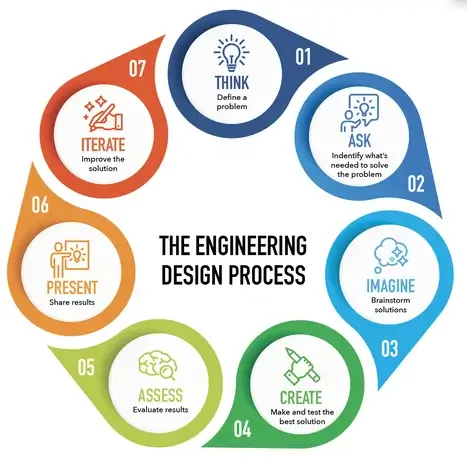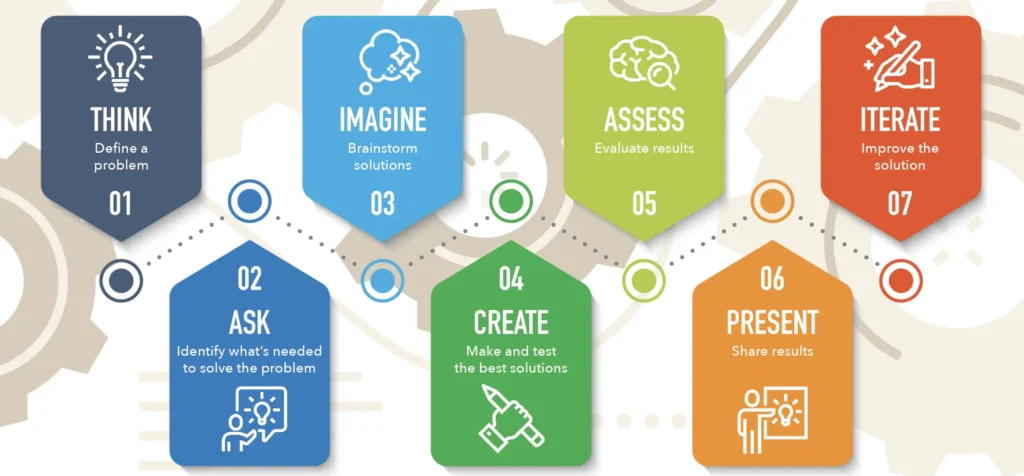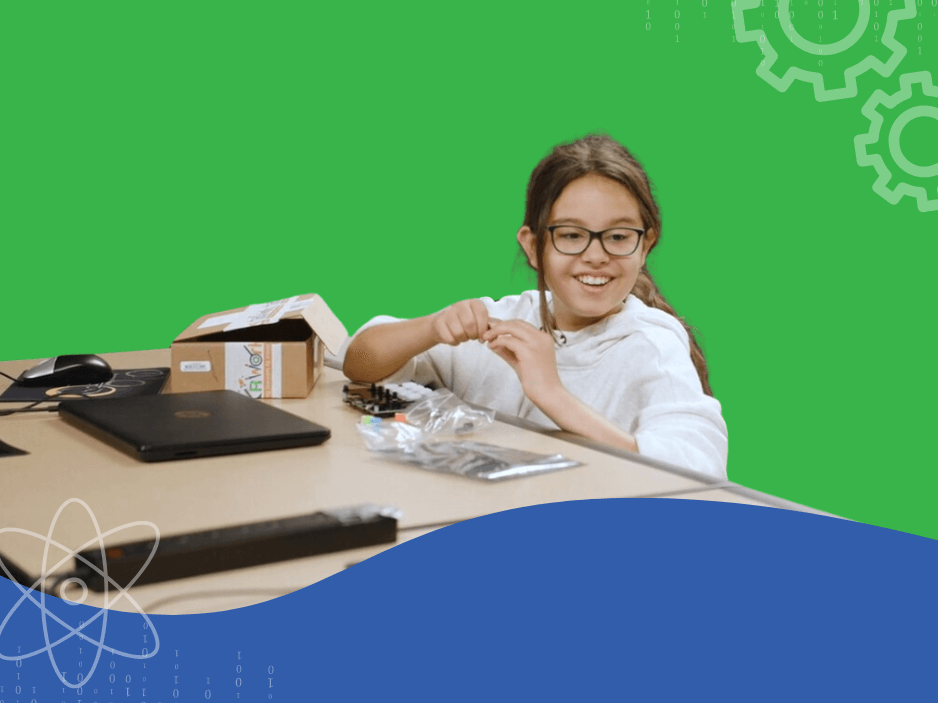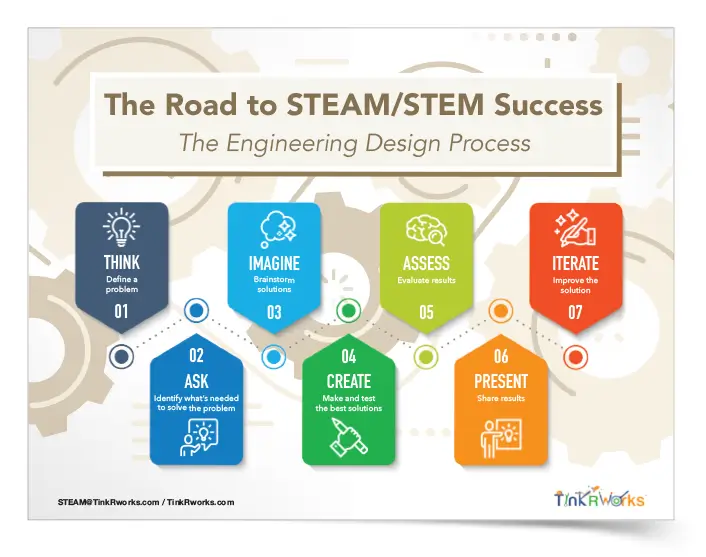In a high-performing STEAM (Science, Technology, Engineering, Art, and Math) classroom, the process of creating is just as important as what you produce. In this article, we will discuss Why is Critical Thinking Important for Students in the STEAM Classroomabout, go in-depth into the Engineering Design Process (EDP), the role of the teacher during each stage of the project, strategies for pushing your students to deeper levels of higher-order thinking, and tools to help your students reflect on what they’ve learned. Plus, you’ll also get access to our printable, The Road to STEAM Success: The Engineering Design Process Poster & Handout.
Why is Critical Thinking Important for Students in the STEAM Classroom? It sets them up for STEAM Success!
For a STEAM lesson to be truly effective, students must not only design and produce a solution, but they also have to be thinking in a STEAM-centered way. When teachers reshape students’ mindsets before, during, and after the Engineering Design Process (EDP), they are showing students how to think like innovators and engendering a creative mindset that transfers far beyond the classroom.
mindset that transfers far beyond the classroom.
One of the reasons that STEAM has such an impact on student success is that it gives way to authentic learning experiences. In a traditional lesson format, there is only one desirable outcome, a predetermined procedure that students must follow to achieve it, and learning is demonstrated by following the script and producing the same product. STEAM lessons turn that format on its head!
Rigorous STEAM activities instead require students to use a vast array of thinking strategies to develop solutions that look entirely unique. STEAM is a pedagogy in which learning is inherent within the Engineering Design Process. Students will be engaged in complex thinking, sharpening their innovation skills, and gaining content knowledge without knowing that the learning process is even taking place. The excitement and buy-in that students feel when they’re in charge of the outcome masks learning as a fun problem-solving puzzle.
But in order to get students to these effortless, monumental learning gains (all while having a blast), educators need to take the time to guide students through the processes and routines of STEAM at each stage of instruction. In this article, we’ll discuss how to get the results you want out of your STEAM activities by breaking down the thinking students should be doing (and the educators’ role) before, during, and after the project:
- Before the project: student thinking should be focused on learning or reviewing each stage of the Engineering Design Process so they understand learning objectives
- During the project: students should be thinking independently, critically, and creatively
- After the project: student thinking should shift towards reflection and the presentation of results in a coherent and academic manner
STEAM-Centered Thinking
Before the STEAM Project– Teaching the Engineer Design Process
Intentionality and planning are key to any successful lesson but even more so with STEAM. It’s vital to get students in a STEAM mindset by teaching them the processes and procedures of the Engineering Design Process (EDP) before you dive into the project itself.
If you’re in the STEAM world, you may have heard of something called the Engineering Design Process. While there are several approaches to implementing a STEAM curriculum, the EDP is the most common. Stemming originally from professional settings, this process has been adopted as the framework for STEAM curricula in a K–12 environment with massive success. The EDP is an inquiry-based model where students learn by asking questions and discovering the answers themselves.
STEAM and EDP pair together nicely because the Engineering Design Process serves as the pedagogical tool for delivering STEAM content. Throughout the EDP, students use a variety of different thinking strategies that shift their mindset and push them to new levels of deep contemplation and innovation. To understand the purpose and structure of STEAM, teachers, and students need to become familiar with the EDP process before the project begins, as well as the roles they will need to play during each step.

Step 1: THINK
- Students’ Role: The aim of STEAM is to solve problems by creating new products, systems, or environments. Before creating solutions, it is essential to define the problem! Otherwise, students could end up creating something only to discover it does not meet their original goal. To define the problem, student thinking should be directed toward answering questions like…
-
What is the problem or need?
-
Who has the problem or need?
-
Why is it important to solve?
-
- Educator’s Role: Without a well-defined problem, it is hard for students to know what they’re aiming for. Educators need to closely observe and guide student thinking during this stage of STEAM to ensure there is a clear-cut objective to work towards. Regardless of whether students are assisted in constructing a driving question or allowed to create one on their own, instructors need to keep student thinking on track toward a feasible solution.
Step 2: ASK
- Students’ Role: In this step, students ask and identify what’s needed to solve the problem. They should be asking clarifying questions, conducting research, and acquiring knowledge to make sure they really understand the problem. Additionally, they should be figuring out how the problem/question connects to their own personal lives.
- Educator’s Role: In their haste to deliver content and make use of precious instructional minutes, educators often skip steps 1 (Ask) and 2 (Imagine) during everyday lessons. However, these two steps are critical for shifting students’ mindsets from listeners to doers, from memorization to innovation, and from passive learners to active participants in the direction of the project. Typical lessons–where students are learning a pre-scripted method for solving a problem–stifle students’ creativity and encourage them to memorize rather than understand the “why.” In contrast, during this step of the EDP process, instructors push students to think deeply about the problem and how it relates to their lives. To ensure this step is successful; educators should be building solid STEAM curricula where they ask students questions that are not only complex and can lead to multiple outcomes but are connected to the real world. (HINT: Need help designing and implementing your own high-quality STEAM curriculum? Check out our no-prep, rigorous TinkRworks STEAM projects!)
Step 3: IMAGINE
- Students’ Role: In this stage, students should be brainstorming any and all ideas. Practical, wild, silly–no thoughts are off-limits here. Through this discovery stage, students are using imaginative thinking to decide on a solution and design their own plans. Then they are bringing their ideas to life by making designs, drawing sketches, listing out tools needed to complete the projects, and making note of constraints. This is where their mindset begins to shift from passive learners to active participants in the lesson direction.
- Educator’s Role: In this step, instructors provide opportunities and participate in discourse that naturally leads students to brainstorm even more solutions. The instructor helps students take ownership of the lesson and develop their mindset from learners to creators and innovators. They also guide students’ thoughts and questions and helping coalesce them into recurring themes/topics/ideas.
Step 4: CREATE
- Students’ Role: In this step, students turn theory into practice. They are fully immersed in hands-on learning and discovering if the proposed solution works through experimenting, building, designing, creating, and innovating.
- Educator’s Role: In this step, educators help guide students as they begin the process of building. They encourage them to try things and see what happens, providing needed materials, and (much earlier) developing intentional lessons that actually allow students to apply theoretical concepts to the engineering process. They also encourage students to shift their mindset and see themselves as scientists, builders, problem-solvers.
Step 5: ASSESS
- Students’ Role: In this final step, students move away from a pass/fail, good/bad mentality and evaluate what went well with their projects and what could be better in the future.
- Educator’s Role: In this stage, teachers help students understand that it’s important to share lessons learned and big takeaways when we present results. They foster resilience by helping students understand that it can take many attempts to solve a problem and that a wrong answer is not a failure. Through this process, students learn how to utilize feedback and overcome setbacks by persisting through challenges.
Step 6: PRESENT
- Students’ Role: Once students evaluate their results, their thinking shifts to presenting their successes and struggles to the group. They should express their findings in an academic and coherent way.
- Educator’s Role: In this step, students learn the art of exploration and come to understand that mistakes are part of the engineering design process. Through project reflection and self-evaluation, students revisit the process, what did/didn’t work and what they could do differently in the future, and consolidate what they’ve learned—deepening the impact of their interdisciplinary STEAM lessons.
Step 7: ITERATE
- Students’ Role: In this final step, students use all that they’ve learned to improve the solution. They are implementing improvements and trying again.
- Educator’s Role: Instructors are helping students adopt a growth mindset. They are helping students to see their failures as opportunities to improve rather than dead-ends.
Download our free The Road to STEAM Success: The Engineering Design Process Poster & Handout and use it to discuss the purpose and structure of a STEAM project.
During the STEAM Project– Teaching Students How to Think Deeply
One of the most incredible things about STEAM education and the Engineering Design Process (EDP) frame is the unmatched innovation it elicits from students. Students are at the center of each project and the educator’s role is to push students to be inquisitive, creative, and forward-thinking. Student voices and ideas take center stage as they are tasked with analyzing problems and coming up with solutions themselves.
But young learners don’t just get to these deep levels of critical thinking on their own. Educators (and curricula) must cultivate an environment where students see themselves as innovators and therefore think like innovators. So, what does that look like in a classroom, and what is happening during STEAM lessons to nurture this mindset?
Educators must consistently encourage students to see themselves as engineers, scientists, designers, and problem-solvers. In order to do that, they must be a “guide on the side” during STEAM lessons rather than a “sage on the stage” directing students to do a series of prescribed, step-by-step instructions. This shift in instruction is so vital to STEAM projects because (as part of the EDP discussed above), successful STEAM is at its very core student-led. The educator’s role shifts away from delivering content (a “stand and deliver” method) to guiding students to explore the content on their own.
Shifting students’ mentalities to see themselves as capable of leading the projects and shifting educators’ mindsets to allow students to guide is crucial to fully utilizing the incredible learning gains possible in STEAM curricula. Handing the reins over to students might not seem like the most efficient way to teach all those content standards, and it really is a huge shift from traditional instructional models. However, it is this very shift that makes all the difference and really moves the needle in terms of student learning gains. Countless studies support the idea that when students are in charge of the lesson outcome, they learn faster, retain more, find more enjoyment in learning, and are more engaged in class. With a student-centered model, learners don’t even realize they’re learning because they’re so engrossed in using their own ideas to innovate solutions. Suddenly their science lesson feels like solving a giant puzzle or winning a game rather than work.
After the STEAM Project–Deep Thinking Through Self-Reflection
After teaching students about the Engineer-Design Process (EDP) and guiding them through the lesson (while keeping students’ voices central), the last piece of a solid STEAM curriculum is providing a space for students to reflect and share.
Self-evaluation is a key piece of the EDP process because it not only pushes students to deeper levels of critical thinking but also helps cultivate a resilient mindset. When students reflect on what they could do better in the future, they see learning as a continual process of growth and improvement. This mindset will help them find success in any field, both academic and professional.
As part of the reflection process, students should take time to report on their strengths and struggles to their classmates in an academic and coherent manner. Teachers can help students see themselves as innovators by nurturing a safe supportive environment in their classroom where failures are seen as an avenue for growth and self-reflection.
In Summary
The beautiful thing about STEAM (and the reason it’s so versatile) is that it’s an educational approach and not a script. STEAM content goes hand in hand with another pedagogical framework for solving tough questions: the Engineering Design Process (EDP). With the help of instructors, students can make huge STEAM learning gains by becoming familiar with the EDP process and shifting their mindset from learners/listeners to doers/problem-solvers. Download The Road to STEAM Success: The Engineering Design Process Poster & Handout and use it in your next STEAM project.



